

Backchurch Lane
Backchurch Lane (Church Lane until the 1860s), running south from Commercial Road to Cable Street, became the
boundary between the parishes of St Mark Whitechapel and St John the
Evangelist-in-the-East
Grove [Golding] Street. The area was densely populated, with a
mix of industrial and residential properties, with dangers to match.
Further details of the area which became St John's parish are here.
Fires and Explosions
| TERRIFIC BOILER EXPLOSION A fearful explosion occurred on the premises known as the Patent Saw Mills, situated in Back Church Lane, Commercial Road East, one of the most densely crowded districts of London. These premises were divided into several compartments, each fitted up with most costly machinery. A little to the left of these compartments stood the steam-boiler house, in which were deposited two boilers, one about 12-horse and the other between 8 and 9-horse power. The latter of these, which had been in use some time, was at work, and although it was observed to move sluggishly, no danger was apprehended; but between 10 and 11 o'clock in the forenoon a tremendous explosion occurred, which threw the whole neighbourhood into dismay. For the space of half a minute after the explosion happened, nothing but a dense mass of steam and dust could be seen, which ascended so high as to darken the neighbourhood in the immediate vicinity of the premises. The instant the steam and dust in some measure began to clear away, a shower of timber, bricks, and portions of heavy machinery fell. Large piles of wood were seen flying in every direction, which, as they fell upon the house-tops, either forced in the roofs or demolished the back or side walls. At the same time one of the boilers, weighing many tons, was lifted from its bearings, and thrown a long distance from its original position; the other was rent in pieces, and one part, weighing nearly two tons, was forced high into the air, and, after travelling a distance of 100 feet, fell into the back yard, striking in its descent the large premises used as counting-houses and offices, forcing in the windows, and partially destroying the front walls. The crash was tremendous, and at the same instant the school-house in Charles Street was partially blown down; two or three houses adjoining had their roofs and back fronts stove in, and an iron tank, weighing upwards of a ton, was driven by the force of the explosion some distance above the house-tops, and falling upon the roof of the mill, broke through and settled amongst the machinery. The devastation was carried far beyond the property. An aged man passing along the road was struck by a piece of iron, which broke both his legs, and he was obliged to be carried to the London Hospital. A boy passing through Church Lane had his arm fractured by the falling of a large piece of brickwork. Mrs. Young was buried in the ruins, and very severely scalded, and otherwise greatly injured. Mrs. Bailey, residing in the same street, who was looking out of the window at the time of the explosion, received so great a shock that she died on the following morning. |
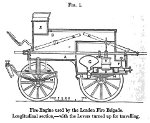 A note on the
development of firefighting in London A note on the
development of firefighting in LondonThe first commercially-successful fire engine was patented by Richard Newsham in 1725, and many were made in different sizes (Buckingham Palace had once of the largest), and Newsham and Rags (his cousin) was established at 18 New Street, Cloth Fair, West Smithfield. They sold around the country and were even exported to the United States. Around 1750 he was bought out by John and Margaret Bristow (John was a churchwarden at St George-in-the-East in 1784), and production continued in Ratcliff Highway until 1831 - their story is told here. Before 1833 there was no co-ordinated system, and no trained firefighters. The 300 parish engines were under the control of often elderly beadles, and the insurance companies had their own equipment. Saving property rather than people was the priority. The Royal Society for the Protection of Life from Fire, founded in 1828, sought to address this by providing fire ladders in streets, and attending fires to give assistance to individuals at risk. 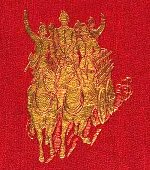 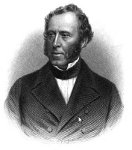 The
London Fire Brigade (originally the
'London Fire-engine Establishment') was created in 1833 by ten
insurance companies working together, the Sun Fire Office taking the
lead. The first Superintendent was
James Braidwood (1800-61) [right], formerly of Edinburgh, where within weeks of
his appointment at the age of 23 dealt with the Great Fire of
Edinburgh. In his second year in London he faced the major fire at
the
Houses of Parliament. The
London Fire Brigade (originally the
'London Fire-engine Establishment') was created in 1833 by ten
insurance companies working together, the Sun Fire Office taking the
lead. The first Superintendent was
James Braidwood (1800-61) [right], formerly of Edinburgh, where within weeks of
his appointment at the age of 23 dealt with the Great Fire of
Edinburgh. In his second year in London he faced the major fire at
the
Houses of Parliament.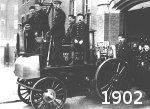 He lived 'over the shop' at Watling Street, and
throughout his career saw through many detailed improvements to
structures, apparatus, training and reporting of fires, detailed in his
book Fire Prevention and Fire Extinction
(Bell and Daldy 1866 - cover right). This was published
posthumously - he died attending the huge fire at Cotton's Wharf,
Tooley Street in 1861. In 1866 the Metropolitan Board of Works assumed
control of the fire service from the insurance companies, fulfilling
one of his hopes; the Metropolitan Fire Brigade became the London Fire
Brigade in 1904. Left is
its first motorised fire engine in 1902.
He lived 'over the shop' at Watling Street, and
throughout his career saw through many detailed improvements to
structures, apparatus, training and reporting of fires, detailed in his
book Fire Prevention and Fire Extinction
(Bell and Daldy 1866 - cover right). This was published
posthumously - he died attending the huge fire at Cotton's Wharf,
Tooley Street in 1861. In 1866 the Metropolitan Board of Works assumed
control of the fire service from the insurance companies, fulfilling
one of his hopes; the Metropolitan Fire Brigade became the London Fire
Brigade in 1904. Left is
its first motorised fire engine in 1902.
|
Entrepreneurs
Backchurch Lane was also a place where entrepreneurs and men of science
lived and worked. Here are some examples.
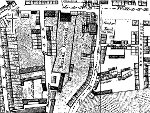 Roque's
map of 1746 shows the area on the north west of Church [Backchurch] Lane as a market
garden. By the turn of the century the first edition of Horwood's map
shows an enclosed area of about half an acre, and the 1813/14 revision
- right - marks it as a burial ground, with a small chapel on the northern edge,
off White Horse Lane [later Commercial Road] marked for the first
time on Greenwood's map of 1824-26; the earliest dated headstone from
excavations in the area is dated 1776. It was one of various private
non-denominational burial grounds established as speculative ventures
as parish churchyards became overcrowded and the population grew
dramatically. It was acquired in the 1830s by Samuel Sheen,
an undertaker who kept a public house opposite. He has planted it with trees and shrubs, which are sufficiently attractive, but the ground is saturated with human putrescence, wrote George Walker in Gatherings from Graveyards (1839). An 1838 pamphlet noted
that Sheen charged between 8s. and 15s. for an adult interment -
somewhat less than parish church burials, at least for non-parishioners (compare the 1840 fees at St George's).
Roque's
map of 1746 shows the area on the north west of Church [Backchurch] Lane as a market
garden. By the turn of the century the first edition of Horwood's map
shows an enclosed area of about half an acre, and the 1813/14 revision
- right - marks it as a burial ground, with a small chapel on the northern edge,
off White Horse Lane [later Commercial Road] marked for the first
time on Greenwood's map of 1824-26; the earliest dated headstone from
excavations in the area is dated 1776. It was one of various private
non-denominational burial grounds established as speculative ventures
as parish churchyards became overcrowded and the population grew
dramatically. It was acquired in the 1830s by Samuel Sheen,
an undertaker who kept a public house opposite. He has planted it with trees and shrubs, which are sufficiently attractive, but the ground is saturated with human putrescence, wrote George Walker in Gatherings from Graveyards (1839). An 1838 pamphlet noted
that Sheen charged between 8s. and 15s. for an adult interment -
somewhat less than parish church burials, at least for non-parishioners (compare the 1840 fees at St George's). | At the Thames Police-office on Saturday another 'burial ground' case was heard. The exposure was the result of a quarrel between two rival undertakers. The facts are these. Samuel Sheen, besides being an undertaker, is the proprietor of a private place of interment called 'Sheen's Cemetery'. William Jeffryes, coffin maker and furnishing-undertaker, in the course of business, conducted the funeral of a child which was to be buried at Sheen's cemetery. The ground had been selected, and the dues paid: but when the funeral party arrived on Tuesday last week, the gates of the cemetery were locked. Admission was obtained through Sheen's house; and it was then discovered that no grave had been dug nor other preparations made. Sheen was absent from home. The coffin was therefore deposited in a grave prepared for an adult; and the funeral service was read by Jeffryes at the request of the mourners. On returning home, Sheen was very angry; he proceeded to Jeffryes' house in Leman Street, and there he uttered much personal abuse, with threats of violence. The defence was that Jeffryes had brought the coffin to annoy his rival; that Sheen was excited when he went to the other house; that Jeffryes then called him a rascal, and threatened to expose his cemetery as a nuisance; and that he thereupon did somewhat forget himself. The defendant was fined 10s. and costs. |

 Stanford's 1862 map, which still delineates the burial ground, shows a Congregational Chapel on the site (but it doesn't fit with any of those described here);
no chapel appears on Weller's map of 1868, presumably because the
building of the western end of the Commercial Road had begun. Mrs Basil Holmes in The London Burial Grounds
(1896/7) reports that the burial ground was used as a cooperage, and then became
Fairclough's yard, and was filled with carts and sheds - including a
new stable built in 1894, the London County Council having declined to
forbid its erection. The site was excavated in 2006-07 (following an
archaelogical report): 258 'contexted' burials were
revealed in 50% of the site (with much disarticulated bone), and the
rest was cleared by an exhumation company. Most burials were in
wooden coffins, and there were three brick vaults; all inscriptions
were recorded, including part of a stone marked The family grave of George and Anna Gregory of Church Lane.
Stanford's 1862 map, which still delineates the burial ground, shows a Congregational Chapel on the site (but it doesn't fit with any of those described here);
no chapel appears on Weller's map of 1868, presumably because the
building of the western end of the Commercial Road had begun. Mrs Basil Holmes in The London Burial Grounds
(1896/7) reports that the burial ground was used as a cooperage, and then became
Fairclough's yard, and was filled with carts and sheds - including a
new stable built in 1894, the London County Council having declined to
forbid its erection. The site was excavated in 2006-07 (following an
archaelogical report): 258 'contexted' burials were
revealed in 50% of the site (with much disarticulated bone), and the
rest was cleared by an exhumation company. Most burials were in
wooden coffins, and there were three brick vaults; all inscriptions
were recorded, including part of a stone marked The family grave of George and Anna Gregory of Church Lane.A squalid place
There are various damning accounts of the area around Backchurch Lane from the
second half of the 19th
century; the page on St John's parish gives examples, but here is one directly related to the street, where James Greenwood Unsentimental Journeys, or
By-ways of the modern Babylon (Ward & Lock 1867) comments on
a particular local trade:
| This
universal fish-frying is the key to another mystery common to the
neighbourhood. In every 'general shop', in every rag and bone shop, in
the high street, and in the hundred courts and filthy alleys that worm
in and out of it, may be seen solid slabs of a tallowy-looking
substance, and marked with a figure 6, 7, or 8, denoting that for as
many pence a pound weight of the suspicious-looking slab may be
obtained. It is bought in considerable quantities by the fish-eaters
for frying purposes, and is by them supposed to be simply and purely
the fat dripping of roast and baked meats, supplied to these shops by
cooks, whose perquisite it is. This, however is a delusion. The
villainous compound is manufactured. There is a 'dripping-maker' near
Seabright-street, Bethnal-green, and another in Backchurch-lane,
Whitechapel, both flourishing men, and the owners of many carts and
sleek cattle. Mutton suet and boiled rice are the chief ingredients
used in the manufacture of the slabs, the gravy of bullocks' kidneys
being stirred into the mess when it is half cold, giving to the whole a
mottled and natural appearance... |
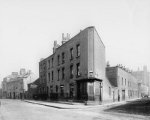
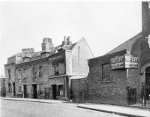
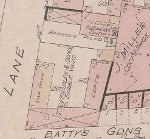
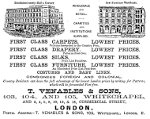
 Left are two 1909 views of Backchurch Lane. On the corner of Backchurch Lane and Batty's Gardens was the stable yard of T. Venables & Sons (shown on Goad's 1899 insurance map right).
They were large-scale drapers and furnishers, at 103-115 Whitechapel
High Street and 2-8 Commercial Street. This was one of the noted East
End emporia, rivalling those of the West End, established in the 1840s
and 1850s. Over the years partnerships within and beyond the family had
come and gone. William and Thomas, silk mercers and haberdashers, had
separated in 1830; William continued as a draper in Lamb's
Conduit Street, but went bankrupt four years later, and Thomas
continued at 103 Whitechapel High Street. (In 1839 Ann Nowlan, a woman
of 40 with six fatherless children, and her 19-year old daughter Mary
Ann Nowlan were transported for seven years for the theft of 23¾ yards
of silk serge, value £3, from the store.) Thomas, John and Robert's
partnership as linen drapers of 34 Aldgate High Street was dissolved in
1854. By 1858 Charles, with his father and brother, was employing 32
young men at the Whitechapel store (in another Old Bailey case of that year, one of
his staff, John Carter,
was sentenced to four years' penal servitude for embezzlement.) Thomas
Glascott left partnership with Charles in 1878; in 1884 John
Venables May, formerly part of the firm and then a dealer in cotton and
wollen fabrics in Cheapside, and a skirt and costume manufacturer in
Bow Common, was declared bankrupt. In 1888 they bought out R & E
Plumpton in Whitechapel Road. In 1892 it became a limited liability
company, all the shares taken by Charles Venables and his managers Mr
Bye and Mr Thomas. They went into voluntary liquidation in 1929. Their
business was part of the local scene. When the Queen visited the East
End in 1876 it was reported that the establishment was tastefully
decorated with flags and shields. In the 1870s, St Paul's School
was one of many local schools to which they supplied special lined
calico for school needlework lessons (standards 5-7), scissor cuts
marked with a black line.
Left are two 1909 views of Backchurch Lane. On the corner of Backchurch Lane and Batty's Gardens was the stable yard of T. Venables & Sons (shown on Goad's 1899 insurance map right).
They were large-scale drapers and furnishers, at 103-115 Whitechapel
High Street and 2-8 Commercial Street. This was one of the noted East
End emporia, rivalling those of the West End, established in the 1840s
and 1850s. Over the years partnerships within and beyond the family had
come and gone. William and Thomas, silk mercers and haberdashers, had
separated in 1830; William continued as a draper in Lamb's
Conduit Street, but went bankrupt four years later, and Thomas
continued at 103 Whitechapel High Street. (In 1839 Ann Nowlan, a woman
of 40 with six fatherless children, and her 19-year old daughter Mary
Ann Nowlan were transported for seven years for the theft of 23¾ yards
of silk serge, value £3, from the store.) Thomas, John and Robert's
partnership as linen drapers of 34 Aldgate High Street was dissolved in
1854. By 1858 Charles, with his father and brother, was employing 32
young men at the Whitechapel store (in another Old Bailey case of that year, one of
his staff, John Carter,
was sentenced to four years' penal servitude for embezzlement.) Thomas
Glascott left partnership with Charles in 1878; in 1884 John
Venables May, formerly part of the firm and then a dealer in cotton and
wollen fabrics in Cheapside, and a skirt and costume manufacturer in
Bow Common, was declared bankrupt. In 1888 they bought out R & E
Plumpton in Whitechapel Road. In 1892 it became a limited liability
company, all the shares taken by Charles Venables and his managers Mr
Bye and Mr Thomas. They went into voluntary liquidation in 1929. Their
business was part of the local scene. When the Queen visited the East
End in 1876 it was reported that the establishment was tastefully
decorated with flags and shields. In the 1870s, St Paul's School
was one of many local schools to which they supplied special lined
calico for school needlework lessons (standards 5-7), scissor cuts
marked with a black line.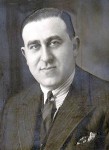
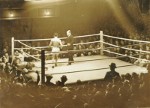
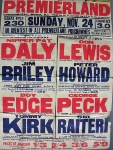 In December 1911 it was renamed Premierland ('Pree-mier-land') and it
incorporated a boxing ring, where many East End boxers began their
careers, many of them Jewish (among them Ted 'Kid' Lewis at the opening match, and Jack 'Kid' Berg).
In 1924 Victor Berliner [left]
and Manny Lyttlestone presided over its most successful era. A 1920's
boxing boom meant
there were three or four shows a week. The crowds were a mix
of Jewish and Irish immigrants and native cockneys: mostly men who
worked as dockers, barrow boys or street traders at nearby Petticoat
Lane. Some contestants were current or ex-professional boxers, and generally those
who weren't had at least boxed for boys' clubs. As well as Lewis and
Berg, Teddy Baldock, Kid Pattenden, Harry Mason, Nipper
Pat Daly and Dick and Harry Corbett were big stars. Former fighter Jack
Hart was the house referee for much of the period, mostly officiating
from outside the ring. Right is
a 1929 poster and a photo of a 1930 bout, where Whitechapel-born Al
Forman (aka Bert 'Kid' Harris') - who boxed extensively in the USA,
Canada and Australia - defeated Fred Webster of Kentish Town to take
the lightweight championship. Cannily, Forman promoted the fight, and
booked the venue, himself.
In December 1911 it was renamed Premierland ('Pree-mier-land') and it
incorporated a boxing ring, where many East End boxers began their
careers, many of them Jewish (among them Ted 'Kid' Lewis at the opening match, and Jack 'Kid' Berg).
In 1924 Victor Berliner [left]
and Manny Lyttlestone presided over its most successful era. A 1920's
boxing boom meant
there were three or four shows a week. The crowds were a mix
of Jewish and Irish immigrants and native cockneys: mostly men who
worked as dockers, barrow boys or street traders at nearby Petticoat
Lane. Some contestants were current or ex-professional boxers, and generally those
who weren't had at least boxed for boys' clubs. As well as Lewis and
Berg, Teddy Baldock, Kid Pattenden, Harry Mason, Nipper
Pat Daly and Dick and Harry Corbett were big stars. Former fighter Jack
Hart was the house referee for much of the period, mostly officiating
from outside the ring. Right is
a 1929 poster and a photo of a 1930 bout, where Whitechapel-born Al
Forman (aka Bert 'Kid' Harris') - who boxed extensively in the USA,
Canada and Australia - defeated Fred Webster of Kentish Town to take
the lightweight championship. Cannily, Forman promoted the fight, and
booked the venue, himself.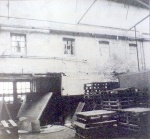
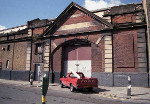 By this date, when most boxing venues had become
grander in style and scale, it had become dilapidated, and a High Court case T.M. Fairclough
& Sons v Berliner [1931] 1 Ch 60 determined
that the owners of the property were entitled to relief. (It turned on
technical issues of joint tenancy, under the recent 1925 Law of
Property Act, and so was frequently cited in the following years.) In due course it
became a garage for Fairclough's motor vehicles - see here
for the story of this firm: 75 years earlier Thomas Morrison Fairclough
has been churchwarden of the parish (descendants recently visited the church). In the 1960s, a New Premierland
boxing
venue was based at Poplar Baths; the old building later became a
warehouse [right - entrance in 1987, with inscription 'People's Palace' still visible; inside around the same time].
By this date, when most boxing venues had become
grander in style and scale, it had become dilapidated, and a High Court case T.M. Fairclough
& Sons v Berliner [1931] 1 Ch 60 determined
that the owners of the property were entitled to relief. (It turned on
technical issues of joint tenancy, under the recent 1925 Law of
Property Act, and so was frequently cited in the following years.) In due course it
became a garage for Fairclough's motor vehicles - see here
for the story of this firm: 75 years earlier Thomas Morrison Fairclough
has been churchwarden of the parish (descendants recently visited the church). In the 1960s, a New Premierland
boxing
venue was based at Poplar Baths; the old building later became a
warehouse [right - entrance in 1987, with inscription 'People's Palace' still visible; inside around the same time].  Charles Kinloch & Co, Backchurch Lane
Charles Kinloch & Co, Backchurch Lane Charles Kinloch (1828-97) was the youngest child of Captain Charles
Kinloch of Gourdie (who had served with the 52nd Regiment in the
Peninsular War); he attended Edinburgh Academy and the University of
Bonn. He married Harriet Kingston, relative of a well-known children's
author. He established a firm of wine and spirits dealers in 1861; the
following year they were advertising at the International Exhibition [left], with premises near Mansion House in the City [right].
Charles Kinloch (1828-97) was the youngest child of Captain Charles
Kinloch of Gourdie (who had served with the 52nd Regiment in the
Peninsular War); he attended Edinburgh Academy and the University of
Bonn. He married Harriet Kingston, relative of a well-known children's
author. He established a firm of wine and spirits dealers in 1861; the
following year they were advertising at the International Exhibition [left], with premises near Mansion House in the City [right].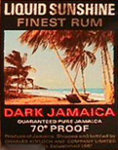
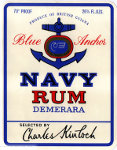
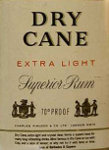 In 1884, with premises at Backchurch Lane and also at 3 Queen Victoria Street, Thomas Mackay
(1849-1912) left the partnership with Kinloch and George Scott. He was a cousin of Kinloch's father
who was keen to be involved in social work but accepted advice to start
in business. He was an unlikely city merchant, but made a substantial
fortune, and retired to write on social questions and to work with the Charity Organisation Society.
Henceforth Scott was the managing director until his death in
1893; he had homes at Eagle Villa, Queen's Road in Peckham and at
Scott-Rea, Tully Powrie, Perthshire. Two years earlier the firm had been incorporated as Charles
Kinloch & Co Ltd, wine, whisky and brandy merchants. In 1888 they advertised themselves as sole UK consignees of Bouvet-Ladubay,
St. Hilaire-St. Florent & Epernay, growers and shippers of extra
royal, sec and brut. But over the years perhaps their most distinctive
product was dark Jamaica rum, which they sold as 'Liquid Sunshine' [labels left].
In 1884, with premises at Backchurch Lane and also at 3 Queen Victoria Street, Thomas Mackay
(1849-1912) left the partnership with Kinloch and George Scott. He was a cousin of Kinloch's father
who was keen to be involved in social work but accepted advice to start
in business. He was an unlikely city merchant, but made a substantial
fortune, and retired to write on social questions and to work with the Charity Organisation Society.
Henceforth Scott was the managing director until his death in
1893; he had homes at Eagle Villa, Queen's Road in Peckham and at
Scott-Rea, Tully Powrie, Perthshire. Two years earlier the firm had been incorporated as Charles
Kinloch & Co Ltd, wine, whisky and brandy merchants. In 1888 they advertised themselves as sole UK consignees of Bouvet-Ladubay,
St. Hilaire-St. Florent & Epernay, growers and shippers of extra
royal, sec and brut. But over the years perhaps their most distinctive
product was dark Jamaica rum, which they sold as 'Liquid Sunshine' [labels left].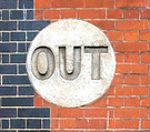
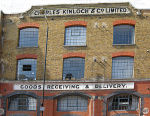
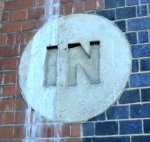 In 1894-5 a fine new warehouse by Hyman Henry Collins was completed. Note
the details, including the carved in and out signs, set into coloured engineering bricks. The firm continued to expand, and pursue creditors - including in 1908
Max Sichel, a bankrupt wine and spirit merchant of Wolverhampton and in
1924 the owners of the unlikely-named Riviera Hotel, Maidenhead.
In 1894-5 a fine new warehouse by Hyman Henry Collins was completed. Note
the details, including the carved in and out signs, set into coloured engineering bricks. The firm continued to expand, and pursue creditors - including in 1908
Max Sichel, a bankrupt wine and spirit merchant of Wolverhampton and in
1924 the owners of the unlikely-named Riviera Hotel, Maidenhead.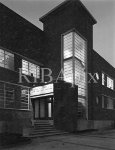 In
1937 they opened a new factory at Queensbury Road, Wembley [later Park
Royal] in 'Modern Movement' style by E.E. Williams & E.G.
Winbourne [left - RIBA image]. By 1950 they were supplying 4,000 lines of wines and spirits
(including Southern Comfort) nationwide, and owned or part-owned four
other companies. Even after they themselves were acquired by Courage
and Barclay in 1957, this process continued, as they bought up five
other firms as non-trading subsidiaries. In 1961, their centenary year,
they produced a 42-page pamphlet The Taste of Kinloch, a handbook of wines and spirits based on the experience of 100 years
(Pamela Joan Vandyke Price, published G. Street). The
company was formally dissolved in 2008; its residual trading address is
now Mercer and Hole, International Press Centre, Shoe Lane EC4.
In
1937 they opened a new factory at Queensbury Road, Wembley [later Park
Royal] in 'Modern Movement' style by E.E. Williams & E.G.
Winbourne [left - RIBA image]. By 1950 they were supplying 4,000 lines of wines and spirits
(including Southern Comfort) nationwide, and owned or part-owned four
other companies. Even after they themselves were acquired by Courage
and Barclay in 1957, this process continued, as they bought up five
other firms as non-trading subsidiaries. In 1961, their centenary year,
they produced a 42-page pamphlet The Taste of Kinloch, a handbook of wines and spirits based on the experience of 100 years
(Pamela Joan Vandyke Price, published G. Street). The
company was formally dissolved in 2008; its residual trading address is
now Mercer and Hole, International Press Centre, Shoe Lane EC4. 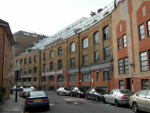
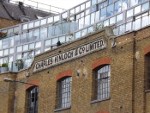

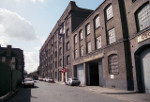
 In 1969 Robert Rayleigh & Co, of the Commercial Road, acquired 107
Backchurch Lane and 26/42 Gowers Walk for clients - 74,000 sq ft with
footage of 150ft to Backchurch Lane. Collins' warehouse eventually became apartments in 1999, with glazed
rooftop extensions, as shown left. Right is the building beside no.107, two views of the street in 1987 and one in 2000.
In 1969 Robert Rayleigh & Co, of the Commercial Road, acquired 107
Backchurch Lane and 26/42 Gowers Walk for clients - 74,000 sq ft with
footage of 150ft to Backchurch Lane. Collins' warehouse eventually became apartments in 1999, with glazed
rooftop extensions, as shown left. Right is the building beside no.107, two views of the street in 1987 and one in 2000.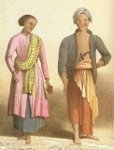 Footnote:
a relative from Scotland, Charles Walter Kinloch, studied at the East
India College, Haileybury - founded by the Honourable East India
Company in 1806 to train young gentlemen for clerkships in the overseas
civil service (it was re-founded in 1862 as 'Haileybury and the
Imperial Services College'). In 1828 he won prizes in law and
Hindustani, and later joined the Bengal civil service, where he served
as a collector, joint magistrate and compiler of statistical reports
(e.g. of Futtehpore in 1851). He also published, under the name 'Bengal
Civilian', Rambles in Java and the Straits in 1852 on travels to Penang, Singapore and Java [plate left] - he was recovering from ill-health and the original title was The Invalid Traveller;
it is reprinted, and still referred to in guidebooks today. He also
wrote about the Bengal mutiny and the 'Kaffir question' in South
Africa. Back in Edinburgh, he produced two novels Robert Grierson (1874) and Leonard Scott (1875).
Footnote:
a relative from Scotland, Charles Walter Kinloch, studied at the East
India College, Haileybury - founded by the Honourable East India
Company in 1806 to train young gentlemen for clerkships in the overseas
civil service (it was re-founded in 1862 as 'Haileybury and the
Imperial Services College'). In 1828 he won prizes in law and
Hindustani, and later joined the Bengal civil service, where he served
as a collector, joint magistrate and compiler of statistical reports
(e.g. of Futtehpore in 1851). He also published, under the name 'Bengal
Civilian', Rambles in Java and the Straits in 1852 on travels to Penang, Singapore and Java [plate left] - he was recovering from ill-health and the original title was The Invalid Traveller;
it is reprinted, and still referred to in guidebooks today. He also
wrote about the Bengal mutiny and the 'Kaffir question' in South
Africa. Back in Edinburgh, he produced two novels Robert Grierson (1874) and Leonard Scott (1875). | West Side ... here is Hooper Street ... Kinloch Chas & Co Ltd, wine merchants 109 Harris Bach, egg merchant 111 Lewis Stepnitsky, tobacconist 111 Philip Herman, barrow lender 111 Yodiesh & Yuchetel, smiths [1] 113 Jacob Jancovitch, harness maker 119 Abraham Shusterman chandlers shop Robert Park & Co Ltd, freight brokers (Arcade Works) [2] Premierland Ltd, cinematograph theatre 149 Mrs Gezalla Herhowitz, dining rooms 151 Bryan Corcoran Ltd, engineers [3] 153 Jacob Breiterman, fancy box maker 155 to 159 John West & Sons Ltd, brassfounder [4] [unnamed public house, landlord John Latchall, at 155] |
East Side 2 Nathan Limpan, dining rooms ... here is Pinchin Street ... [16 Blacksmiths Arms Tavern [5]] Browne & Eagle Limited, wool warehouse keepers ... here is Ellen Street ... [48 picture shop in 1891] [50 butcher in 1891] [58 chandler's shop in 1891] [62 chandler's shop in 1891] [64 Prince of Wales, landlord William Pratt, in 1891] 66 Abraham Smith, tailor [tailor in 1891] 68 Simon Gullovitch, confectioner [dairy in 1891] 70 Morris Gershman, tailor [draper in 1891] 72 John Grybus, beer retailer [6] ... here is Edward Street ... |
74 Solomon Zuckerkandel, provision merchant [7] 78 Hagee Hoosin, refreshment rooms [86 Coach & Horses - [8]] ... here is Boyd Street ... Co-operative Wholesale Society Ltd ... here is Fairclough Street ... 120 Mrs Kate Bloom, chandlers shop ... here is Sander Street ... 128 Mrs Annie Yudkin, fried fish shop 130 Mrs Sarah Ginsberg, tobacconist |
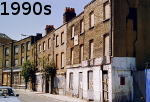
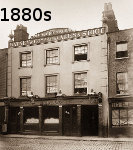 [1] This was formerly the site of the Cherry Tree public house (formerly no.54) - right
in the 1880s, and the site (between the trees) in the 1990s - from at
least 1839; Montagu Dolby, and then his wife Alice, were the last
landlords. In 1883 Philip Garcia, a greengrocer aged 29, was charged along with others with passing counterfeit coins. Dolby said Garcia
and Howard came to my house together and called for a pint of mild and
bitter, and tendered me a shilling — I found it was bad, broke it in my
teeth into two pieces, chucked the pieces on the counter, and Howard picked them up — Howard paid for the liquor with 3d. good money — they are occasional customers. Garcia, who lived at Everard Street with his mother Esther, also tendered counterfeit coins at the Dog & Truck and Brewers' Arms in Backchurch Lane, George IV in Berners Street, the Lord Nelson in Fairclough Street and at half a dozen local shops. He was sentenced to 18 months hard labour.
[1] This was formerly the site of the Cherry Tree public house (formerly no.54) - right
in the 1880s, and the site (between the trees) in the 1990s - from at
least 1839; Montagu Dolby, and then his wife Alice, were the last
landlords. In 1883 Philip Garcia, a greengrocer aged 29, was charged along with others with passing counterfeit coins. Dolby said Garcia
and Howard came to my house together and called for a pint of mild and
bitter, and tendered me a shilling — I found it was bad, broke it in my
teeth into two pieces, chucked the pieces on the counter, and Howard picked them up — Howard paid for the liquor with 3d. good money — they are occasional customers. Garcia, who lived at Everard Street with his mother Esther, also tendered counterfeit coins at the Dog & Truck and Brewers' Arms in Backchurch Lane, George IV in Berners Street, the Lord Nelson in Fairclough Street and at half a dozen local shops. He was sentenced to 18 months hard labour. [5] The original address of the Blacksmiths Arms Tavern, just north of the railway viaduct [1868 map shows Blacksmiths Arms Place] was no.16; in 1873 its
licensee Eliza Moriarty, trading as 'Charles Fisher', was declared
bankrupt. Its later address was 2 Pinchin Street (after Thomas Street was renamed); it had a German-born landlord Antioni Kelfer in the 1880s.
[5] The original address of the Blacksmiths Arms Tavern, just north of the railway viaduct [1868 map shows Blacksmiths Arms Place] was no.16; in 1873 its
licensee Eliza Moriarty, trading as 'Charles Fisher', was declared
bankrupt. Its later address was 2 Pinchin Street (after Thomas Street was renamed); it had a German-born landlord Antioni Kelfer in the 1880s.
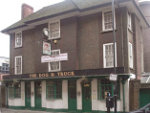 [6]
This was the Dog and Truck. John Grybus was (probably) Russian; his son Charles Andrew, born 1890,
later took over the tenancy. The pub was rebuilt in 1935, designed by William Stewart, to serve the Berner estate behind.
[6]
This was the Dog and Truck. John Grybus was (probably) Russian; his son Charles Andrew, born 1890,
later took over the tenancy. The pub was rebuilt in 1935, designed by William Stewart, to serve the Berner estate behind.
| TWO MILES RACE BETWEEN PUDNEY AND TRAINER, FOR ONE HUNDRED POUNDS This match, which has for a length of time past totally engrossed the attention and excited the speculation ot the patrons and supporters of pedestrianism, came off on Monday last at Garratt-lane, Wandsworth, in presence of a vast concourse of the lovers of that manly pastime. The competitors were both men who have acquired much celebrity in their respective localities, Pudney in London, Trainer in and about Liverpool and Manchester. Pudney has been for some time the holder of thc Champion's Belt as a10 mile runner, and it was supposed that he might risk his laurels were he to run for a shorter distance, his paramount qualities being those of stamina and endurance. He, nevertheless, boldly entered the lists on Monday last with the northern hero, and as the sequel proved, had no cause to regret his so doing. The weather, considering that it was the middle of November, was remarkably fine, the course in capital order, and everything conducted in tho fairest and most impartial manner. The gentlemen from the north (much to our surprise) backed Trainer at 3 to 2, and ultimately were offering 2 to 1 on their pet, which made us suspect there was a "screw loose" somewhere, but on personally visiting on Pudney, and questioning him as to his state of health and condition, we felt assured this this was all "bounce". A referee having been appointed from our office, and all the preliminaries arranged at a few minutes after the appointed time (three o'clock), the men toed the scratch, and after about ten minutes' dodging for the start, got away, Trainer with a trifling load, which he maintained throughout the first and second Iaps; in the middle of the third lap, Pudney passed his man for a yard or two as if to feel his position and capabilities, and having ascertained the supremacy of both, drew back for a while, and let his opponent again take the lead. At the termination of the fourth Iap he was about a yard ahead, but, making a tremendous rush down the first stretch af the fifth lap, ere he had traversed it he left his adversary some twenty yards en arrière, when the latter, finding that he was altogether outpaced and outmatched, gave up the fruitless contest, Pudney from this out, going at his leisure. We did not time the pace throughout, but the first mile was done in something like 4min. 40sec. The winner can have the stakes by calling at our office next Thursday, at twelve o'clock. They will be duly presented to Pudney in the evening at his own house, the Coach and Horses, Back Church-lane, Commercial-road, where he wishes his backers and friends to attend. J. Trainer wishes us to inform pedestrians that it will be useless for any one tn challenge him at present, as he seriously injured himself in this race. |
| My
first remembrance of seeing any running was at the Hackney Wick ground,
where the course was only a furlong. That was some forty-five years
ago, and the occasion on which I made my acquaintance with it was a ten
miles race, and a genuine one. A man named Pudney had a sort of school
of runners with whom he used to tour the country. Among them was the
Red Indian, Deerfoot, who was always allowed to win. In the troupe,
however, there were at least two men who could lose him, one being
White, of Gateshead, and the other C. Lang, vvhose nickname was the
'Crow-catcher'. For some reason or other White fell out with Pudney, and as a
result of the disagreement White announced his intention of running on
his own at Hackney Wick, and winning. Pudney said "You shall not do
that, because Lang can beat you, and he shall go on his own." Deerfoot
was ignored altogether. White was very fit indeed, and he ran the first
seven miles round the small and awkward course in thirty-five minutes,
with Lang in close attendance. At this point Lang fell completely
exhausted, and White trotted on quite comfortably, and finished the ten
miles in fifty-two minutes, Deerfoot being distanced by about
three-quarters of a mile. That was my first experience of the running
path. |
 In 1904 the issue of the Coach & Horses'
licence went to the Court of Appeal before the Master of the Rolls (Sir
Richard Henn Collins) and Stirling and Matthew LJJ, reported as Chambers & others v Tower Magistrates [1904] 2 K.B. 903.
The local licensing justices had refused a licence to R.H. Coborn
(Chambers' employee) because his predecessor Joseph Arch had been
convicted of selling spirits without a licence, and the pub was closed.
All turned on the interpretation of previous Licensing Acts: licences
of 'privileged pubs' (those which had been continuously in business
since before the Act of 1869) could only be forfeited on four specific
grounds - basically, for severe misconduct. Had the Coach and Horses
forfeited this status because there was a break after Arch's removal
(despite Coburn's attempt to get a temporary licence)? The Court of
Appeal, overturning the ruling of the Divisional Court, said yes, and
therefore the licensing justices had wider powers. This case was
significant as it was just before the coming into force of a new
Licensing Act which was to further tighten up the licensing laws, as the pamplet left explains.
In 1904 the issue of the Coach & Horses'
licence went to the Court of Appeal before the Master of the Rolls (Sir
Richard Henn Collins) and Stirling and Matthew LJJ, reported as Chambers & others v Tower Magistrates [1904] 2 K.B. 903.
The local licensing justices had refused a licence to R.H. Coborn
(Chambers' employee) because his predecessor Joseph Arch had been
convicted of selling spirits without a licence, and the pub was closed.
All turned on the interpretation of previous Licensing Acts: licences
of 'privileged pubs' (those which had been continuously in business
since before the Act of 1869) could only be forfeited on four specific
grounds - basically, for severe misconduct. Had the Coach and Horses
forfeited this status because there was a break after Arch's removal
(despite Coburn's attempt to get a temporary licence)? The Court of
Appeal, overturning the ruling of the Divisional Court, said yes, and
therefore the licensing justices had wider powers. This case was
significant as it was just before the coming into force of a new
Licensing Act which was to further tighten up the licensing laws, as the pamplet left explains. 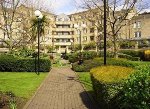

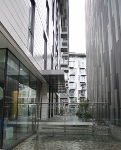
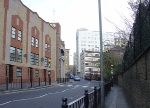
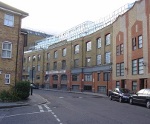
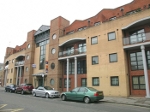 Backchurch Lane today
Backchurch Lane today  is another new court. See here for Brown & Eagle's wool warehouse buildings, now The Woolhouse and New Loom House.
is another new court. See here for Brown & Eagle's wool warehouse buildings, now The Woolhouse and New Loom House.